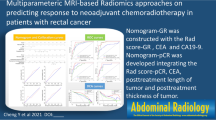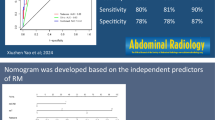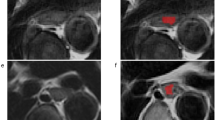Abstract
Objectives
To build and validate a multi-parametric MRI (mpMRI)-based radiomics nomogram for early prediction of treatment response to neoadjuvant chemotherapy (NAC) in locally advanced gastric cancer.
Methods
Baseline MRI were retrospectively enrolled from 141 patients with gastric adenocarcinoma who received NAC followed by radical gastrectomy. According to pathologic response of tumor regression grading (TRG), patients were labeled as responders (TRG = 0 + 1) and non-responders (TRG = 2 + 3) and further divided into a training (n = 85) and validation dataset (n = 56). Radiomics score (Radscore) were built from T2WI, ADC, and venous phase of dynamic-contrasted-enhanced MR imaging. Clinical information, laboratory indicators, MRI parameters, and follow-up data were also recorded. According to multivariable regression analysis, an mpMRI radiomics nomogram was built and its predictive ability was evaluated by ROC analysis. Decision curve analysis was applied to evaluate the clinical usefulness. Kaplan-Meier survival curves based on the nomogram were used to estimate the progression-free survival (PFS) and overall survival (OS) in the validation dataset.
Results
Both single sequence–based Radscores and mpMRI radiomics nomogram were associated with pathologic response (p < 0.001). The nomogram achieved the highest diagnostic ability with area under ROC curve of 0.844 (95% CI, 0.749–0.914) and 0.820 (95% CI, 0.695–0.910) in the training and validation datasets. The hazard ratio of the nomogram for PFS and OS prediction was 2.597 (95% CI: 1.046–6.451, log-rank p = 0.023) and 2.570 (95% CI: 1.166–5.666, log-rank p = 0.011).
Conclusions
The mpMRI-based radiomics nomogram showed preferable performance in predicting pathologic response to NAC in LAGC.
Key Points
• This study investigated the value of multi-parametric MRI-based radiomics in predicting pathologic response to neoadjuvant chemotherapy in locally advanced gastric cancer.
• The nomogram incorporating T2WI Radscore, ADC Radscore, and DCE Radscore as well as Borrmann classification outperformed the single sequence–based Radscore.
• The nomogram also exhibited a promising prognostic ability for patient survival and enriched radiomics studies in gastric cancer.






Similar content being viewed by others
Abbreviations
- ADC:
-
Apparent diffusion coefficients
- AJCC:
-
American Joint Committee on Cancer
- AUC:
-
Area under the ROC curve
- CA199:
-
Carbohydrate antigen 199
- CA724:
-
Carbohydrate antigen 724
- CEA:
-
Carcinoembryonic antigen
- CI:
-
Confidence interval
- CT:
-
Computed tomography, X-ray
- DCA:
-
Decision curve analysis
- DCE-MRI:
-
Dynamic-contrasted-enhanced magnetic resonance imaging
- DKI:
-
Diffusion kurtosis imaging
- DL:
-
Deep learning
- DWI:
-
Diffusion-weighted imaging
- GC:
-
Gastric cancer
- HR:
-
Hazard ratio
- LAGC:
-
Locally advanced gastric cancer
- mpMRI:
-
Multi-parametric magnetic resonance imaging
- MRI:
-
Magnetic resonance imaging
- NAC:
-
Neoadjuvant chemotherapy
- NCCN:
-
National Comprehensive Cancer Network
- NPV:
-
Negative predictive value
- OS:
-
Overall survival
- PFS:
-
Progression-free survival
- PPV:
-
Positive predictive value
- Radscore:
-
Radiomics score
- ROC:
-
Receiver operating characteristic
- Star-VIBE:
-
Stack-of-stars volume interpolated breath-hold examination
- TRG:
-
Tumor regression grading
- VP:
-
Venous phase
References
Sung H, Ferlay J, Siegel RL et al (2021) Global cancer statistics 2020: GLOBOCAN estimates of incidence and mortality worldwide for 36 cancers in 185 countries. CA Cancer J Clin 71:209–249
Gao K, Wu J (2019) National trend of gastric cancer mortality in China (2003-2015): a population-based study. Cancer Commun (Lond) 39:24. https://doi.org/10.1186/s40880-019-0372-x
Miller KD, Nogueira L, Mariotto AB et al (2019) Cancer treatment and survivorship statistics, 2019. CA Cancer J Clin 69:363–285
Cunningham D, Allum WH, Stenning SP et al (2006) Perioperative chemotherapy versus surgery alone for resectable gastroesophageal cancer. N Engl J Med 355:11–20
Russell MC (2016) Comparison of neoadjuvant versus a surgery first approach for gastric and esophagogastric cancer. J Surg Oncol 114:296–303
Ajani JA, Bentrem DJ, Besh S et al (2013) Gastric cancer, version 2.2013: featured updates to the NCCN Guidelines. J Natl Compr Canc Netw 11:531–546
Coccolini F, Nardi M, Montori G et al (2018) Neoadjuvant chemotherapy in advanced gastric and esophago-gastric cancer. Meta-analysis of randomized trials. Int J Surg 51:120–127
Robb WB, Mariette C (2012) Predicting the response to chemotherapy in gastric adenocarcinoma: who benefits from neoadjuvant chemotherapy? Recent Results Cancer Res 196:241–268
Shi C, Berlin J, Branton PA et al (2020) Protocol for the examination of specimens from patients with carcinoma of the stomach (Version: Stomach 4.1.0.0) [EB/OL]. Northfield: College of American pathologists February. https://documents.cap.org/protocols/cp-giupper-stomach-20-4100.pdf
Napel S, Mu W, Jardim-Perassi BV, Aerts HJWL, Gillies RJ (2018) Quantitative imaging of cancer in the postgenomic era: Radio(geno)mics, deep learning, and habitats. Cancer 124(24):4633–4649
Bi WL, Hosny A, Schabath MB et al (2019) Artificial intelligence in cancer imaging: clinical challenges and applications. CA Cancer J Clin 69:127–157
Li J, Dong D, Fang M et al (2020) Dual-energy CT-based deep learning radiomics can improve lymph node metastasis risk prediction for gastric cancer. Eur Radiol 30:2324–2333
Gillies RJ, Kinahan PE, Hricak H (2016) Radiomics: images are more than pictures, they are data. Radiology 278:563–577
Dong D, Tang L, Li ZY et al (2019) Development and validation of an individualized nomogram to identify occult peritoneal metastasis in patients with advanced gastric cancer. Ann Oncol 30:431–438
Zhang W, Fang M, Dong D et al (2020) Development and validation of a CT-based radiomic nomogram for preoperative prediction of early recurrence in advanced gastric cancer. Radiother Oncol 145:13–20
Sun KY, Hu HT, Chen SL et al (2020) CT-based radiomics scores predict response to neoadjuvant chemotherapy and survival in patients with gastric cancer. BMC Cancer 20:468
Song R, Cui Y, Ren J et al (2022) CT-based radiomics analysis in the prediction of response to neoadjuvant chemotherapy in locally advanced gastric cancer: a dual-center study. Radiother Oncol 171:155–163
Fu J, Tang L, Li ZY et al (2020) Diffusion kurtosis imaging in the prediction of poor responses of locally advanced gastric cancer to neoadjuvant chemotherapy. Eur J Radiol 128:108974. https://doi.org/10.1016/j.ejrad.2020.108974
Giganti F, Ambrosi A, Chiari D et al (2017) Apparent diffusion coefficient by diffusion-weighted magnetic resonance imaging as a sole biomarker for staging and prognosis of gastric cancer. Chin J Cancer Res 29:118–126
Joo I, Lee JM, Han JK, Yang HK, Lee HJ, Choi BI (2015) Dynamic contrast-enhanced MRI of gastric cancer: correlation of the perfusion parameters with pathological prognostic factors. J Magn Reson Imaging 41:1608–1614
Horvat N, Veeraraghavan H, Khan M et al (2018) MR imaging of rectal cancer: radiomics analysis to assess treatment response after neoadjuvant therapy. Radiology 287:833–843
Liu Z, Li Z, Qu J et al (2019) Radiomics of multiparametric MRI for pretreatment prediction of pathologic complete response to neoadjuvant chemotherapy in breast cancer: a multicenter study. Clin Cancer Res 25:3538–3547
Sun C, Tian X, Liu Z et al (2019) Radiomic analysis for pretreatment prediction of response to neoadjuvant chemotherapy in locally advanced cervical cancer: a multicentre study. EBioMedicine 46:160–169
Chen W, Wang S, Dong D et al (2019) Evaluation of lymph node metastasis in advanced gastric cancer using magnetic resonance imaging-based radiomics. Front Oncol 9:1265. https://doi.org/10.3389/fonc.2019.01265
Li J, Fang M, Wang R et al (2018) Diagnostic accuracy of dual-energy CT-based nomograms to predict lymph node metastasis. Eur Radiol 28:5241–5249
Meng L, Dong D, Chen X et al (2021) 2D and 3D CT radiomic features performance comparison in characterization of gastric cancer: a multi-center study. IEEE J Biomed Health Inform 25:755–763
Lehmann TM, Gönner C, Spitzer K (2001) Addendum: B-spline interpolation in medical image processing. IEEE Trans Med Imaging. 20(7):660–665
de Vos BD, Berendsen FF, Viergever MA, Sokooti H, Staring M, Išgum I (2019) A deep learning framework for unsupervised affine and deformable image registration. Med Image Anal 52:128–143
Finazzi S, Poole D, Luciani D, Cogo PE, Bertolini G (2011) Calibration belt for quality-of-care assessment based on dichotomous outcomes. PLoS One 6:e16110. https://doi.org/10.1371/journal.pone.0016110
Vickers AJ, Cronin AM, Elkin EB, Gonen M (2008) Extensions to decision curve analysis, a novel method for evaluating diagnostic tests, prediction models and molecular markers. BMC Med Inform Decis Mak 8:53. https://doi.org/10.1186/1472-6947-8-53
DeLong ER, DeLong DM, Clarke-Pearson DL (1988) Comparing the areas under two or more correlated receiver operating characteristic curves: a nonparametric approach. Biometrics 44:837–845
Deng W, Wang Y, Liu Z, Cheng H, Xue Y (2014) HemI: a toolkit for illustrating heatmaps. PLoS One 9:e111988. https://doi.org/10.1371/journal.pone.0111988
Stocker D, Manoliu A, Becker AS et al (2018) Image quality and geometric distortion of modern diffusion-weighted imaging sequences in magnetic resonance imaging of the prostate. Invest Radiol 53:200–206
Fiset S, Welch ML, Weiss J et al (2019) Repeatability and reproducibility of MRI-based radiomic features in cervical cancer. Radiother Oncol 135:107–114
Borggreve AS, Goense L, Brenkman HJF et al (2019) Imaging strategies in the management of gastric cancer: current role and future potential of MRI. Br J Radiol 92:20181044. https://doi.org/10.1259/bjr.20181044
Yan HHN, Siu HC, Law S et al (2018) A comprehensive human gastric cancer organoid biobank captures tumor subtype heterogeneity and enables therapeutic screening. Cell Stem Cell 23:882–897.e11
Díaz Del Arco C, Ortega Medina L, Estrada Muñoz L et al (2021) Are Borrmann's types of advanced gastric cancer distinct clinicopathological and molecular entities? A Western study. Cancers (Basel) 13(12):3081
Cheng J, Wang Y, Zhang CF et al (2017) Chemotherapy response evaluation in a mouse model of gastric cancer using intravoxel incoherent motion diffusion-weighted MRI and histopathology. World J Gastroenterol 23:1990–2001. https://doi.org/10.3748/wjg.v23.i11.1990
Cui Y, Zhang J, Li Z et al (2022) A CT-based deep learning radiomics nomogram for predicting the response to neoadjuvant chemotherapy in patients with locally advanced gastric cancer: a multicenter cohort study. EClinicalMedicine 46:101348. https://doi.org/10.1016/j.eclinm.2022.101348
Li Q, Feng QX, Qi L et al (2022) Prognostic aspects of lymphovascular invasion in localized gastric cancer: new insights into the radiomics and deep transfer learning from contrast-enhanced CT imaging. Abdom Radiol (NY) 47(2):496–507
Funding
This study has received funding by the Science and Technology Development Foundation of Henan Province (202102310736), the Henan Provincial Medical Science and Technology Project (SBGJ202003011), the Projects of the General Programs of the National Natural Science Foundation of China (No.81972802), and the Special funding of the Henan Health Science and Technology Innovation Talent Project (No.YXKC2021054, YXKC2020011).
Author information
Authors and Affiliations
Corresponding authors
Ethics declarations
Guarantor
The scientific guarantor of this publication is Jinrong Qu.
Conflict of interest
The authors of this manuscript declare no relationships with any companies whose products or services may be related to the subject matter of the article.
Statistics and biometry
No complex statistical methods were necessary for this paper.
Informed consent
Written informed consent was not required for this study because this is a retrospective diagnostic study, and was waived by the Institutional Review Board of Zhengzhou University.
Ethical approval
Institutional Review Board approval was obtained.
Methodology
• retrospective
• diagnostic or prognostic study
• performed at one institution
Additional information
Publisher’s note
Springer Nature remains neutral with regard to jurisdictional claims in published maps and institutional affiliations.
Supplementary Information
ESM 1
(DOCX 2.55 MB)
Rights and permissions
Springer Nature or its licensor (e.g. a society or other partner) holds exclusive rights to this article under a publishing agreement with the author(s) or other rightsholder(s); author self-archiving of the accepted manuscript version of this article is solely governed by the terms of such publishing agreement and applicable law.
About this article
Cite this article
Li, J., Yin, H., Wang, Y. et al. Multiparametric MRI-based radiomics nomogram for early prediction of pathological response to neoadjuvant chemotherapy in locally advanced gastric cancer. Eur Radiol 33, 2746–2756 (2023). https://doi.org/10.1007/s00330-022-09219-y
Received:
Revised:
Accepted:
Published:
Issue Date:
DOI: https://doi.org/10.1007/s00330-022-09219-y




